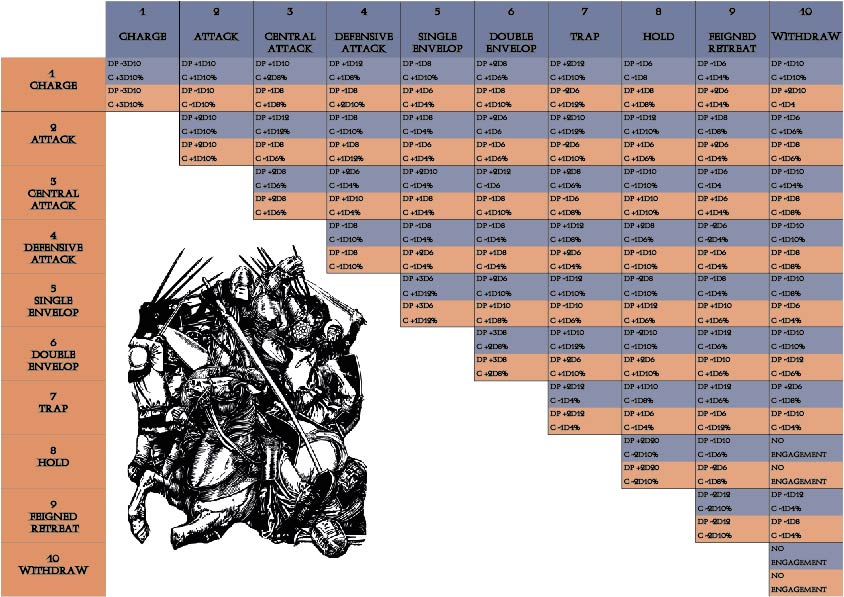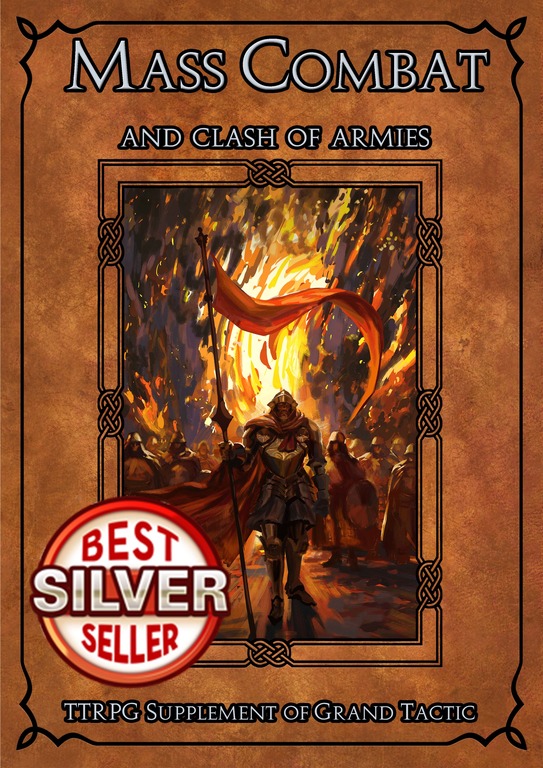Mass combat and clash of armies is uncommon in tabletop roleplaying games, D&D and the like.
However, it is possible that some players eventually want to run a campaign that have strategic and politic implications.
Wars and military campaign represent one of the most used tool to pursue political goals in a more persuasive way, especially when diplomacy fails.
In addition, some characters may have accumulated enough wealth, prestige and power to raise a company of soldiers on their own…and they may want to do something more than looting treasures and fight evil villains.
When talking about Mass Combat you can follow two paths.
- Creating a system of rules for Tactical Combat.
- Creating a system of rules for Strategic Combat (or Grand Tactic).
Let’s see both.
TACTICAL MASS COMBAT
Tactical mass combat means that you handle an army clash on a tactical map. On the map two specific armies are facing each other. You have direct control on the tactic by moving each element of your army like cavalries, infantries, ranged units and so on.
Warhammer is an example of tactical combat, a successful one indeed.
The Battlesystem, published by TSR, is a less famous example of rules made to run skirmishes between armies.
Tactical mass combat, in order to be enjoyable, requires a detailed scenario with obstacles, features and other things that can add flavor and make the army clash challenging.
This kind of approach moves the action toward the management of the army in strictest sense.
In such a scenario, where you plan to run a military campaign, you have to handle with each battle on each battlefield…or at least the most important ones.
STRATEGIC MASS COMBAT
Strategic mass combat engage the issue in a different way. Your battlefield will be the geographic map – those maps with the hexagons just to make it clear. On the strategic map you find capitals, cities, towns, castles, rivers, mountains, roads and so on. Now imagine that, on the same map, you can place one or more army. An army is garrisoning a fortress, protecting a key city, or blocking a vital trade route, etcetera. This implies possessing a strategic view of the whole situation. The armies move on the map and time is measured in terms of days.
How armies clash and how to manage mass combat?
In strategic mass combat, a clash of armies is handled with a quick roll of dice, where you apply one or more modifiers to the roll and then you add all this stuff to a sort of core value. These modifiers may refer to the terrain, the tactic, the type of army, the presence or not of cavalry, the presence or not of spellcasters, the specific race of the army, the experience of the army as a whole, etcetera.
Long story short, we have three elements to consider in order to resolve the issue:
i) The base force of the army. A sort of intrinsic value of the army that depends on the nature itself of the army.
ii) The modifiers. Which is a list of things that may be true or not, and may increase or decrease the base force.
iii) The dice roll. The random aspect of the whole matter We need to think about what and how many dice to roll.
Base Force
The base force may be the sum of values like leadership, equipment, average hit dice or hit points of the army, training, and other variable that strictly depends on the army as a selfstanding element.
In addition, you can include discipline and experience of the army. Discipline may be useful to perform special actions, whilst experience is a variable that increases the force of the army and make it a unique entity.
Modifiers
Modifiers are values that affects the base force of the army, but do not depend on the army itself. Circumstances like the troop ratio against the enemy army, the morale of the army before facing a specific enemy, the environment and the terrain, and other details that are appropriate.
Dice Roll
The dice roll is the same for any army, and allows to introduce a bit of randomness when it is time to calculate the outcome of the battle.
What dice and how many dice to roll, should be pondered on how much the base force and the modifiers weight on the total force of the army.
If you decide to set 2d6 as the dice roll, you must calibrate the modifiers accordingly, so that the dice roll does not overwhelm the battle outcome.
TACTICS
Even if you are playing at strategic level, it doesn’t mean that tactics do not play a key role during a clash of armies. The difference with a tactical mass combat is that tactics produce an effect without the need to make any movement on the map.
You can imagine a list of tactics, and every tactics can work as modifiers do. A more interesting options is to create a table where each specific tactic, cross with another specific tactic, thus generating modifiers.
Imagine two armies that enter the battlefield, and both sides decide to charge at each other; two charging armies usually produce a high number of casualties, and it is hard to maneuver an army once it has engaged the enemy.
Imagine now that one side decides to charge, whilst the other decides to form a defensive square. The outcome of the battle will be different.

BATTLE OUTCOME
At this point, you only need to define what is the battle outcome. The battle outcome is, at least ideally, the difference between the battle score of both sides – answering the question how good each side was on the battlefield.

I have created a pdf whose title is MASS COMBAT & Grand Tactic.
It is available on DrivethuRpg. Just have a look at the preview!
